Want a touch of green without the hassle of real grass? Fake grass rugs look great, but choosing the right one is tough. This guide makes decorating with them simple.
You can use artificial grass rugs to create green, low-maintenance areas anywhere. Outdoors, they work great on patios, balconies, and decks. Indoors, they make fun playrooms or unique accent pieces. Just choose the right type for the space and your needs.
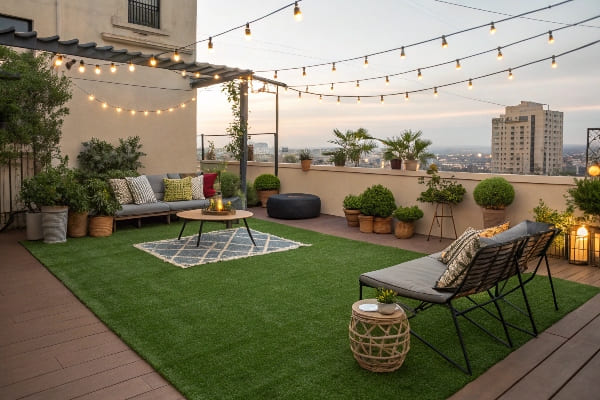
I’ve seen clients transform their spaces with just a simple grass rug. It’s amazing what a little green can do. But before you buy, it’s important to understand what makes a grass rug different from a full turf installation. Let’s break it down so you can make the best choice for your project.
What’s the Difference Between Artificial Turf and an Artificial Grass Rug?
Are turf and grass rugs the same thing? Picking the wrong one for your project can lead to problems. Let’s clearly define the differences to avoid any mistakes.
The main difference is scale and installation. Artificial turf is sold in large rolls for permanent, full-coverage installations with infill. An artificial grass rug is a pre-cut, bound piece used like a standard area rug, often without infill, for smaller, non-permanent applications1.
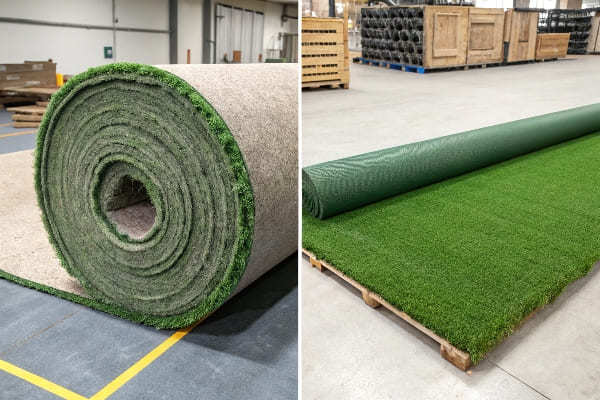
When I first started in the factory, I saw these two products being made side-by-side. To an outsider, they might look similar, but their purpose is completely different. One is for major projects, the other is for simple decoration. Understanding this is the first step to a successful purchase. It helps you budget correctly and get a product that actually fits your needs. A full turf roll for a small balcony is a waste of money and material. A small rug for a whole yard just won’t work.
Key Distinctions
Let’s look at a simple table to make it clearer. I show this to clients all the time to help them decide.
| Feature | Artificial Turf | Artificial Grass Rug |
|---|---|---|
| Size | Large rolls (e.g., 4m x 25m) | Pre-cut sizes (e.g., 2m x 3m) |
| Installation | Permanent, requires infill | Non-permanent, place and use |
| Edges | Unfinished, need to be secured | Bound or finished edges |
| Backing | Heavy-duty, designed for drainage | Often lighter, may have non-slip features |
| Best Use | Lawns, sports fields, large areas | Patios, balconies, playrooms, accents |
| Cost | Priced per square meter | Price per piece/rug |
When to Choose Which?
Choose artificial turf when you are covering a large, permanent area like a backyard or a football pitch. This is an investment in your property. Choose an artificial grass rug when you need a flexible, movable, and decorative green surface for a smaller space.
How Do You Choose the Best Artificial Grass Rug for Outdoor Use?
Want a green balcony that lasts? Many rugs fade or get waterlogged outside. Learn to pick a truly durable outdoor grass rug that can handle sun and rain.
For outdoor use, choose a rug with excellent UV protection2 to prevent fading and a perforated backing for proper drainage. Look for durable materials like polyethylene3 that can withstand different weather conditions. A shorter pile height is often easier to clean outdoors.
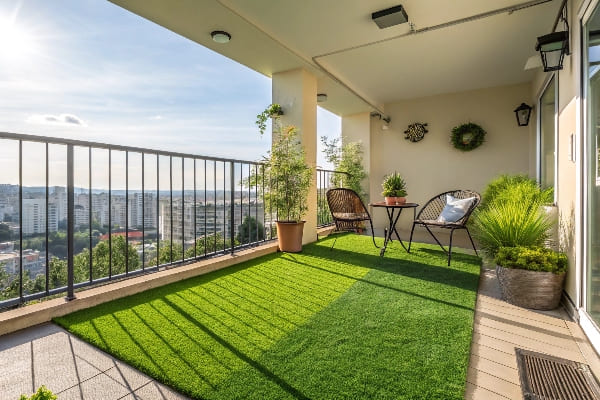
Many customers ask me about using grass rugs on their patios or decks. The biggest mistake is buying a cheap rug that isn’t made for the outdoors. It will look bad very quickly. I always tell them to check the product specifications for a few key features. These features are non-negotiable for any product that has to survive outside, especially in sunny or rainy climates. A good outdoor rug should look great for years, not just one season.
Must-Have Features for Outdoor Rugs
- UV Stability: The sun is the biggest enemy of artificial grass. Without good UV inhibitors mixed into the yarn, the green color will fade to a pale blue or gray. Always ask the supplier about the level of UV protection2.
- Proper Drainage: An outdoor rug will get rained on. The backing must have drainage holes4 to let water pass through. Without them, water will pool on the surface, leading to mold, mildew, and a squishy mess.
- Durable Materials: The fibers need to be tough. Polyethylene (PE) is a great choice because it’s soft but strong. Avoid materials that absorb water or become brittle in the cold.
Common Outdoor Applications
- Patios and Decks: Instantly adds a soft, green touch to hard surfaces.
- Balconies: Creates a mini lawn in an apartment.
- Pool Areas: Provides a non-slip, comfortable surface around the pool.
- Rooftop Gardens: Defines a seating area on a rooftop terrace.
What Should You Look for in an Indoor Artificial Grass Rug?
Want to create a fun, green space inside? Some fake grass rugs are stiff and shed fibers everywhere. I’ll show you how to choose one that’s soft and safe.
For indoor rugs, prioritize softness and safety. Look for a longer pile height for a plusher feel and a non-slip backing to keep it in place. Ensure it’s made from non-toxic materials5, especially if it’s for a child’s playroom or pet area.
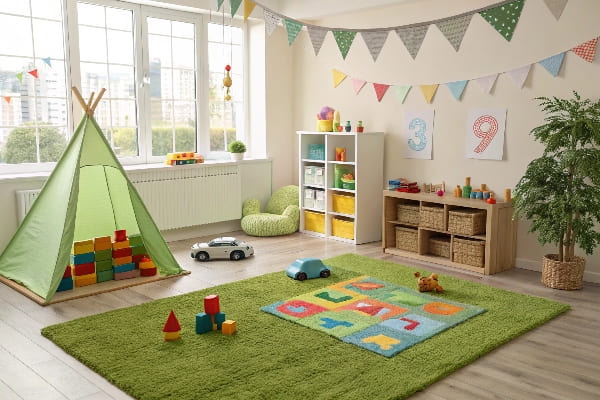
When you bring a product inside your home, your priorities change. Drainage is not important, but comfort and safety are everything. I’ve had clients create amazing indoor spaces, from jungle-themed bedrooms to relaxing office corners. The key is choosing a rug that feels good to touch and is safe for everyone in the family. A scratchy, industrial-feeling grass is fine for outside, but inside you want something that adds to the comfort of your home.
Comfort is Key
The softness of a rug is determined by its material and pile height. For indoor use, a taller pile height (around 30-40mm) feels more luxurious underfoot. Softer materials like a high-quality Polyethylene (PE) or Polyamide (PA/Nylon) are best. Nylon is extremely resilient and soft, making it a premium choice for high-traffic indoor area6s.
Safety First
- Non-Slip Backing: This is crucial. An indoor rug should not slide around on a polished floor. Look for a rug with a built-in rubber or latex non-slip backing.
- Non-Toxic Materials: This is the most important factor, especially for kids and pets. Make sure the rug is certified lead-free and free of other harmful heavy metals. Always ask your supplier for safety certifications.
Creative Indoor Uses
- Children’s Playrooms: Create an "outdoor" play area inside.
- Themed Bedrooms: Perfect for a sports-themed or nature-themed room.
- Home Office: Put a small rug under your desk for a relaxing footrest.
- Pet Training Areas: A designated, easy-to-clean spot for pets.
Which Artificial Grass Rugs Do We Recommend?
Feeling lost in a sea of grass rug options? It’s tough to tell quality from junk online. Let me share some types I trust for great results.
I recommend different rugs for different needs. For outdoors, a short-pile polyethylene3 rug with high UV stability and drainage is best. For indoors, a taller polyamide (nylon) or soft polyethylene3 rug with a non-slip back works well. Always check the material specifications before buying.
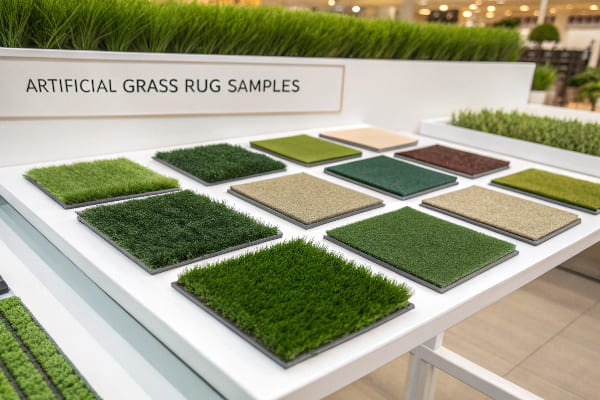
There is no single "best" artificial grass rug. The best one is the one that is right for your specific project. When a client asks for my recommendation, I don’t give them a product name. Instead, I ask them, "Where will you use it?" The answer to that question tells me everything I need to know. From my years of experience, I’ve learned to match the product’s technical specs to the customer’s needs. A good supplier should be able to do this for you. They should guide you to the right material and construction for your application, ensuring you get the best value and performance.
A Quick Comparison Table
Here is a simple guide I use to help my customers choose.
| Application | Recommended Material | Pile Height | Key Features |
|---|---|---|---|
| Outdoor Patio/Balcony | Polyethylene (PE) | 20-30mm | High UV Stability, Drainage Holes |
| Indoor Kid’s Room | Soft Polyethylene (PE) | 30-40mm | Non-Toxic, Soft Feel, Non-Slip Back |
| High-Traffic Indoor Area | Polyamide (PA/Nylon) | 25-35mm | Extremely Durable, Resilient, Soft |
| Pet Area | Polypropylene (PP) or PE | 15-25mm | Durable, Easy to Clean, Good Drainage |
What Are Some Common Questions About Fake Grass Rugs?
Do you still have some nagging questions? Small uncertainties can stop you from finishing a project. Let’s tackle the most frequently asked questions right now so you feel confident.
People often ask about cleaning, durability, and safety. Can you clean them easily? Yes, just hose down outdoor rugs or vacuum indoor ones. Are they safe for pets and kids? Yes, if you choose non-toxic, lead-free options. How long do they last? Several years with proper care.

After all the technical talk, customers usually have a few simple, practical questions. These are important because they are about living with the product every day. I always take the time to answer these clearly because a confident customer is a happy customer. When you know how to care for your rug and what to expect, you will be much more satisfied with your purchase. So, let’s go over the most common questions I hear from buyers around the world.
How do I clean my artificial grass rug?
For an outdoor rug, it is very simple. You can just hose it down with water. For tougher dirt or stains, use a mild soap and a soft brush, then rinse well. For indoor rugs, you can vacuum them just like a regular carpet. Use a brush attachment for better results. For spills, blot the area immediately and clean with a damp cloth.
Will the rug get hot in the sun?
Yes, like any dark-colored surface, an artificial grass rug can get warm in direct, intense sunlight. However, some newer yarns are designed with heat-reduction technology. Also,
lighter green colors will stay cooler than very dark greens. A quick spray with a hose can cool it down instantly if needed.
Is it safe for my pets?
Absolutely, as long as you choose the right product. Look for rugs that are certified non-toxic and lead-free. The durability is also good for pets, as they cannot dig through it. For pet urine, it will drain through an outdoor rug if you rinse it with water. For indoor accidents, clean it up as you would on a normal carpet.
Conclusion
Choosing the right artificial grass rug is easy. Just match the rug’s features, like drainage and softness, to your specific indoor or outdoor needs for a perfect result.
-
Find out how non-permanent applications can enhance smaller spaces with flexibility. ↩
-
Learn about the importance of UV protection in maintaining the color and quality of grass rugs. ↩ ↩
-
Understand why polyethylene is a popular choice for its durability and weather resistance. ↩ ↩ ↩
-
Explore how drainage holes prevent water pooling and maintain the integrity of outdoor rugs. ↩
-
Find out why choosing non-toxic materials is crucial for safety, especially for kids and pets. ↩
-
Explore options for durable artificial grass that withstands heavy foot traffic. ↩
_画板-1.png)
_画板-1.png)